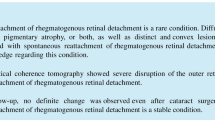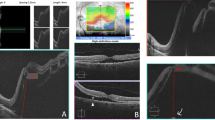Abstract
Purpose
To determine the characteristics and appearance rate of epiretinal proliferation (ERP) on SD-OCT after surgery for rhegmatogenous retinal detachment (RRD) repair.
Methods
One hundred eight eyes of 108 patients who underwent one or more surgeries for RRD were enrolled. The eyes with other maculopathies that were directly related to RRD were excluded. Image acquisition was performed with SD-OCT (Heidelberg Engineering, Germany). Clinical charts were reviewed to assess clinical and surgical findings. Statistical analyses were performed using XLSTAT (Assinsoft, Paris, France).
Results
ERP was found in 9.3% eyes (n = 10). The mean initial visual acuity (logMAR) was 1.34 ± 0.82 in the ERP group compared to 0.49 ± 0.70 in the non-ERP group. PVR was present in 70.0% and chronic macular edema was found in 80.0% of eyes which developed ERP. The mean number of vitreoretinal surgeries in eyes with ERP was 3.3 ± 1.19 and only 1.44 ± 1.02 in eyes without. Silicone oil was used in 60.0% of eyes which developed ERP compared to 13.9% in the non-ERP group.
Conclusion
ERP is a late-onset postoperative finding in eyes with RRD and can occur in absence of macular holes. Overall, ERP is more frequent in eyes with complicated courses of RRD including multiple operations, PVR, usage of silicone oil, and chronic macular edema.


Similar content being viewed by others
Change history
19 January 2022
A Correction to this paper has been published: https://doi.org/10.1007/s00417-021-05516-2
References
Parolini B, Schumann RG, Cereda MG, Haritoglou C, Pertile G (2011) Lamellar macular hole: a clinicopathologic correlation of surgically excised epiretinal membranes. Invest Ophthalmol Vis Sci 52(12):9074–9083
Compera D, Entchev E, Haritoglou C, Scheler R, Mayer WJ, Wolf A, Kampik A, Schumann RG (2015) Lamellar hole-associated epiretinal proliferation in comparison to epiretinal membranes of macular pseudoholes. Am J Ophthalmol 160(2):373-384.e1
Pang CE, Maberley DA, Freund KB, White VA, Rasmussen S, To E, Matsubara JA (2016) Lamellar hole-associated epiretinal proliferation: a clinicopathologic correlation. Retina (Philadelphia, Pa) 36(7):1408–1412
Pang CE, Spaide RF, Freund KB (2014) Epiretinal proliferation seen in association with lamellar macular holes: a distinct clinical entity. Retina (Philadelphia, Pa) 34(8):1513–1523
Schumann RG, Hagenau F, Guenther SR, Wolf A, Priglinger SG, Vogt D (2019) Premacular cell proliferation profiles in tangential traction vitreo-maculopathies suggest a key role for hyalocytes. Ophthalmologica 242(2):106–112
Chehaibou I, Pettenkofer M, Govetto A, Rabina G, Sadda SR, Hubschman JP (2020) Identification of epiretinal proliferation in various retinal diseases and vitreoretinal interface disorders. Int J Retin Vitr 6:31
Obana A, Sasano H, Okazaki S, Otsuki Y, Seto T, Gohto Y (2017) Evidence of carotenoid in surgically removed lamellar hole-associated epiretinal proliferation. Invest Ophthalmol Vis Sci 58(12):5157–5163
Compera D, Entchev E, Haritoglou C, Mayer WJ, Hagenau F, Ziada J, Kampik A, Schumann RG (2015) Correlative microscopy of lamellar hole-associated epiretinal proliferation. J Ophthalmol 2015:450212
Mudhar HS (2020) A brief review of the histopathology of proliferative vitreoretinopathy (PVR). Eye (Lond) 34(2):246–250
Lange C, Feltgen N, Junker B, Schulze-Bonsel K, Bach M (2009) Resolving the clinical acuity categories “hand motion” and “counting fingers” using the Freiburg Visual Acuity Test (FrACT). Graefes Arch Clin Exp Ophthalmol 247(1):137–142
Foos RY (1978) Nonvascular proliferative extraretinal retinopathies. Am J Ophthalmol 86(5):723–725
Pang CE, Spaide RF, Freund KB (2015) Comparing functional and morphologic characteristics of lamellar macular holes with and without lamellar hole-associated epiretinal proliferation. Retina (Philadelphia, Pa) 35(4):720–726
Govetto A, Lalane RA, Sarraf D, Figueroa MS, Hubschman JP (2017) Insights into epiretinal membranes: presence of ectopic inner foveal layers and a new optical coherence tomography staging scheme. Am J Ophthalmol 175:99–113
Bringmann A, Wiedemann P (2012) Müller glial cells in retinal disease. Ophthalmologica 227(1):1–19
Francone A, Essilfie J, Sarraf D, Preti RC, Monteiro MLR, Hubschman JP (2019) Effect of laser photocoagulation on macular edema associated with macular holes. Retin Cases Brief Rep. https://doi.org/10.1097/ICB.0000000000000901
Tackenberg MA, Tucker BA, Swift JS, Jiang C, Redenti S, Greenberg KP, Flannery JG, Reichenbach A, Young MJ (2009) Müller cell activation, proliferation and migration following laser injury. Mol Vis 15:1886–1896
Conedera FM, Arendt P, Trepp C, Tschopp M, Enzmann V (2017) Müller glia cell activation in a laser-induced retinal degeneration and regeneration model in zebrafish. J Vis Exp (128):56249. https://doi.org/10.3791/56249
Author information
Authors and Affiliations
Corresponding author
Ethics declarations
Ethical approval
All procedures performed in studies involving human participants were in accordance with the ethical standards of the University of California, Los Angeles Institutional Review Board (IRB) and with the 1964 Helsinki declaration and its later amendments or comparable ethical standards. This article does not contain any studies with animals performed by any of the authors.
Informed consent
This type of study does not require informed consent.
Conflict of interest
The authors declare no competing interests.
Additional information
Publisher's note
Springer Nature remains neutral with regard to jurisdictional claims in published maps and institutional affiliations.
The original version of this article was revised. The Key messages details is now corrected.
Supplementary Information
Below is the link to the electronic supplementary material.
Rights and permissions
About this article
Cite this article
Pettenkofer, M., Chehaibou, I., Pole, C. et al. Epiretinal proliferation after rhegmatogenous retinal detachment. Graefes Arch Clin Exp Ophthalmol 260, 1509–1516 (2022). https://doi.org/10.1007/s00417-021-05502-8
Received:
Revised:
Accepted:
Published:
Issue Date:
DOI: https://doi.org/10.1007/s00417-021-05502-8




